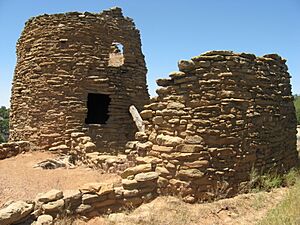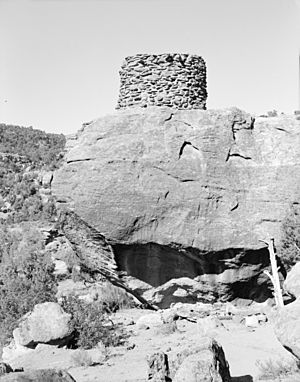Navajo pueblitos facts for kids
The Navajo Pueblitos, also known as Dinétah Pueblitos, are special archaeological sites found in the northwest part of New Mexico, United States. These sites are usually small buildings made of stone and wood. Experts believe the Navajo people built them in the late 1600s and early 1700s.
These sites are located in the Dinétah, which is the traditional homeland of the Navajo tribe. "Pueblitos" means "little villages" in Spanish. They are often found in places that are easy to defend, like along the edges of mesas or on isolated rocks. The buildings can have one to six rooms. They might be tall towers, cliff dwellings, or even look like small forts.
Contents
Where are Pueblitos Found?
Most pueblito sites are on land managed by the United States Bureau of Land Management. They are mainly in Rio Arriba and San Juan counties in New Mexico. Many early Navajo sites, including pueblitos, are grouped together in the Largo and Gobernador canyons. These canyons drain towards the San Juan River.
Pueblo People's Influence
These sites, now in ruins, are from a time archaeologists call the Gobernador phase of Navajo history. This period began with the Pueblo Revolt in 1680. During this revolt, Spanish people were forced out of New Mexico by different Pueblo tribes. The Spanish returned in 1692. It seems some Pueblo people then moved to the mesas and canyons where the Navajo lived.
Many archaeologists thought that a large number of Pueblo people came to the Dinétah region. This was believed to cause a mix of Pueblo and Navajo cultures in the 1700s. The idea was that Pueblo refugees helped the Navajo build the pueblitos.
It's still debated how many Pueblo people actually lived with the Navajos during this time. Spanish reports suggest that parts of some Tewa and two Jemez communities might have found safety with the Navajos. However, records from the Hopi Pueblos show that most refugees from the Rio Grande area went to Hopi land. Some experts now think only a few hundred Pueblo people might have fled to Navajo country.
Why Were Pueblitos Built?
Most experts agree that the Pueblitos were built for defense. This was true whether Navajos, Puebloans, or both built them. The Dinétah area was a frontier in the early 1700s. Navajos and possibly Pueblo refugees defended it against Spanish attacks and raids from the Ute and Comanche tribes.
The defensive plans at Pueblito sites had two main parts:
- Early Warning: The sites were placed where people could see approaching enemies from far away.
- Controlling Access: Sites were often located so they could be seen from other sites, allowing for communication.
How Pueblitos Were Built
Pueblitos are usually two-story buildings made of masonry (stone and mortar). They are often built on rock outcrops or cliff edges. The shape of the building often follows the shape of the rock it sits on. Inside, walls divide the space into rooms. These rooms often have rounded corners.
The stone used was usually sandstone blocks and slabs found nearby. These were set in mud mortar. The inside walls of rooms were often covered with hand-pressed adobe mortar.
The ceilings were supported by logs from piñon and juniper trees. These main beams are called vigas. Smaller juniper and piñon slats, called latillas, were placed across the vigas. Sometimes, adobe was put on top of the latillas to make a floor. Some sites even have Spanish-style hooded fireplaces. Many pueblitos are still in good condition, with walls standing 4 to 15 feet high.
You can also find forked-stick hogans throughout the Dinétah region. Some are even next to pueblitos. Hogans usually have three main posts that form a tripod shape. Split juniper slats are placed on this frame to make a cone. Originally, these slats were covered with mud mortar, but this layer has washed away over time.
Important Pueblito Sites
Some of the larger and well-known pueblito sites include:
- Adolpho Canyon
- Christmas Tree Ruin
- Crow Canyon Archaeological District
- Frances Canyon Ruin
- Hooded Fireplace Site
- Largo School Ruin
- Old Fort Ruin
- Shaft House Ruin
- Simon Canyon Ruin
- Split Rock Ruin
- Tapacito Ruin
- Three Corn Ruin



